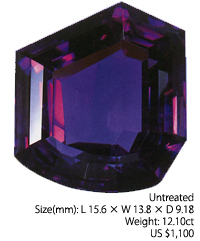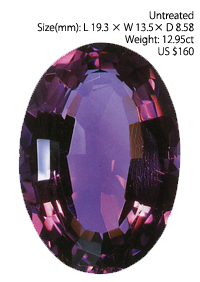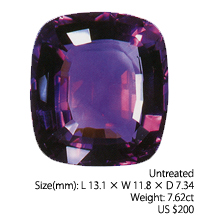CHARACTERISTICS BY COUNTRY OF ORIGIN
Amethyst is the purple variety of quartz, the crystalline from of silica that occurs throughout the world. It has a hardness of 7 and is a gemstone of superb durability. Because of the abundance of silica on the earth’s surface, gemstones with a hardness of 7 or greater are desirable- softer materials are subject to severe abrasion. Current major producers of amethyst are Zambia, Brazil, and Uruguay, each producing material with characteristic qualities. Although now depleted, amethyst was mined several hundred years ago in Idar-Oberstein, Germany, which has since become a pioneering cutting center of gemstones. Russia and Sri Lanka also produce amethyst.
|
 |
Zambia
Zambia is a source of fine-quality amethyst, with full-scale production having started in the early 1980s. Zambian amethyst has a deep, attractive purple color. However, because it often contains inclusions and concentrations of color (called color banging or color zoning), cutters will improvise with angles and faceting styles to create as clean a stone as possible. Inclusions and saturation of color tend to differ by source due to differences in natural environmental conditions during the formation of gem crystals.
|
|
Brazil
There are many amethyst mines in Brazil. As with other gemstones, characteristics of the rough material digger from mine to mine, and quality varies. It is common to see material that is large but pale in color, as well as dark material that is lacking in brilliance. Citrine (yellow quartz) occurs in nature, but most of it is amethyst that has been heated, and much Brazilian amethyst is subjected to this treatment.
|
 |
 |
Uruguay
Amethyst from Uruguay, located south of Brazil, often exhibits an uneven distribution of purple, with much of the material showing characteristic color banding or color zoning. If colorless areas are visible when a stone is viewed face-up, the quality is judged to be poor, while a stone that is attractive when seen face-up it is valued highly even if colorless areas can be seen from other angles. The material is similar to the amethyst found in southern Brazil, providing a good example of why source characteristics should be based on geological regions rather than national borders. |
|
 |
JUDGING QUALITY
Amethyst is generally mined in large quantities. Material with a high level of transparency is fashioned into gemstones as shown in the quality scale.
Factors in judging the quality of amethyst are richness of color, level of transparency, color zoning, and the presence of eye-visible imperfections. Amethysts range widely from those of a very deep color to those that are quite pale. It is interesting to compare the darker tones to that of rhodolite garnet and the lighter tones to that of aquamarine. A pure purple, with no grayish or brownish tint, with a high level of transparency, and with a tone of 6 or a slightly dark 5 would be gem quality. Such a stone would possess substantial beauty.
On the chart to the next page, tones 7 to 5 are Zambian amethyst, and tones 4 to 2 are Brazilian.
|
|